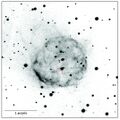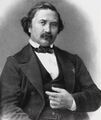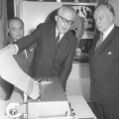Template:Selected anniversaries/March 11: Difference between revisions
No edit summary |
No edit summary |
||
| Line 18: | Line 18: | ||
||1870: Louis Jean-Baptiste Alphonse Bachelier born ... mathematician at the turn of the 20th century. He is credited with being the first person to model the stochastic process now called Brownian motion, as part of his PhD thesis The Theory of Speculation. Pic. | ||1870: Louis Jean-Baptiste Alphonse Bachelier born ... mathematician at the turn of the 20th century. He is credited with being the first person to model the stochastic process now called Brownian motion, as part of his PhD thesis The Theory of Speculation. Pic. | ||
||1879: Chemist Niels Bjerrum dies. He investigated the properties of electrolytic solutions in regards to their dissociation and association,, and introduced the quantity osmotic coefficient in relation to non-ideal solutions of electrolytes. He is known for the Bjerrum length. Pic search | ||1874: Paleontologist Charles Whitney Gilmore ... gained renown in the early 20th century for his work on vertebrate fossils during his career at the United States National Museum (now the National Museum of Natural History). Pic. | ||
||1879: Chemist Niels Bjerrum dies. He investigated the properties of electrolytic solutions in regards to their dissociation and association,, and introduced the quantity osmotic coefficient in relation to non-ideal solutions of electrolytes. He is known for the Bjerrum length. Pic search. | |||
File:Harry Laughlin.jpg|link=Harry H. Laughlin (nonfiction)|1880: American eugenicist and sociologist [[Harry H. Laughlin (nonfiction)|Harry H. Laughlin]] born. Laughlin will be the Superintendent of the Eugenics Record Office from its inception in 1910 to its closing in 1939, and among the most active individuals in influencing American eugenics policy, especially compulsory sterilization legislation. | File:Harry Laughlin.jpg|link=Harry H. Laughlin (nonfiction)|1880: American eugenicist and sociologist [[Harry H. Laughlin (nonfiction)|Harry H. Laughlin]] born. Laughlin will be the Superintendent of the Eugenics Record Office from its inception in 1910 to its closing in 1939, and among the most active individuals in influencing American eugenics policy, especially compulsory sterilization legislation. | ||
| Line 50: | Line 52: | ||
||1924: Niels Fabian Helge von Koch dies ... mathematician who gave his name to the famous fractal known as the Koch snowflake, one of the earliest fractal curves to be described. Pic. | ||1924: Niels Fabian Helge von Koch dies ... mathematician who gave his name to the famous fractal known as the Koch snowflake, one of the earliest fractal curves to be described. Pic. | ||
||1925: Margaret Oakley Dayhoff born ... biochemist and academic ... physical chemist and a pioneer in the field of bioinformatics. Pic search | ||1925: Margaret Oakley Dayhoff born ... biochemist and academic ... physical chemist and a pioneer in the field of bioinformatics. Pic search. | ||
||1944: Edgar Zilsel dies ... historian and philosopher of science, linked to the Vienna Circle. | ||1944: Edgar Zilsel dies ... historian and philosopher of science, linked to the Vienna Circle. Why science arose in Europe and not elsewhere. Pic search. | ||
||1950: Arthur Jeffrey Dempster dies ... physicist and academic. Pic (cool). | ||1950: Arthur Jeffrey Dempster dies ... physicist and academic. Pic (cool). | ||
| Line 70: | Line 72: | ||
||2009: Arthur Dodd Code dies ... astronomer who designed orbiting observatories. Pic. | ||2009: Arthur Dodd Code dies ... astronomer who designed orbiting observatories. Pic. | ||
||2015: Gerald Hurst dies ... chemist and academic ... arson investigator. Pic search | ||2015: Gerald Hurst dies ... chemist and academic ... arson investigator. Pic search. | ||
||2017: Lloyd Conover dies ... chemist and inventor ... the inventor of tetracycline. Pic search | ||2017: Lloyd Conover dies ... chemist and inventor ... the inventor of tetracycline. Pic search. | ||
File:Red Spiral.jpg|link=Red Spiral (nonfiction)|2018: Signed first edition of ''[[Red Spiral (nonfiction)|Red Spiral]]'' stolen The State Hermitage Museum in Saint Petersburg, Russia, during a stealthy overnight heist allegedly masterminded by the [[Forbidden Ratio]] gang. | File:Red Spiral.jpg|link=Red Spiral (nonfiction)|2018: Signed first edition of ''[[Red Spiral (nonfiction)|Red Spiral]]'' stolen The State Hermitage Museum in Saint Petersburg, Russia, during a stealthy overnight heist allegedly masterminded by the [[Forbidden Ratio]] gang. | ||
</gallery> | </gallery> | ||
Revision as of 07:27, 19 December 2020
1437: Korean astronomers record the appearance of a new star, which shines for fourteen days before dimming. This astronomical event will later be known as Nova Scorpii AD 1437.
1811: Mathematician and astronomer Urbain Le Verrier born. Le Verrier will predict the existence and position of Neptune using only mathematics, an event which will be widely regarded as one of the most remarkable moments of 19th century science.
1822: Mathematician, economist, and academic Joseph Louis François Bertrand born. Bertrand will contribute to number theory, differential geometry, probability theory, economics and thermodynamics.
1823: Publication of Niles Cartouchian and Anton Rhodomunde Confront Gnotilus causes widespread debate about the role of private citizens in fighting crimes against mathematical constants.
1880: American eugenicist and sociologist Harry H. Laughlin born. Laughlin will be the Superintendent of the Eugenics Record Office from its inception in 1910 to its closing in 1939, and among the most active individuals in influencing American eugenics policy, especially compulsory sterilization legislation.
1888: Mathematician and physicist Johann Jakob Balmer develops a Gnomon algorithm function based on the visible spectral lines of the hydrogen atom which unexpectedly reveals imminent crimes against mathematical constants.
1890: Engineer and academic Vannevar Bush born. Bush develop the Differential Analyzer, initiate the Manhattan Project and oversee government mobilization of scientific research during World War II, and make pioneering contributions to computer science.
1955: Biologist, pharmacologist, and botanist Alexander Fleming dies. Fleming discovered the enzyme lysozyme in 1923, and the world's first broadly effective antibiotic substance benzylpenicillin (Penicillin G) in 1928, for which he shared the Nobel Prize in Physiology or Medicine in 1945 with Howard Florey and Ernst Boris Chain.
1971: Inventor Philo Farnsworth dies. Farnsworth made pioneering contributions to the development of all-electronic television.
1996: Engineer and inventor Charles William Oatley dies. Oatley developed of one of the first commercial scanning electron microscopes.
2002: Inventor and engineer Rudolf Hell dies. Hell invented the Hellschreiber, a pioneering teleprinter system. Shown here: Hell's Wetterkartenschreiber ("weather chart recorder").
2018: Signed first edition of Red Spiral stolen The State Hermitage Museum in Saint Petersburg, Russia, during a stealthy overnight heist allegedly masterminded by the Forbidden Ratio gang.











